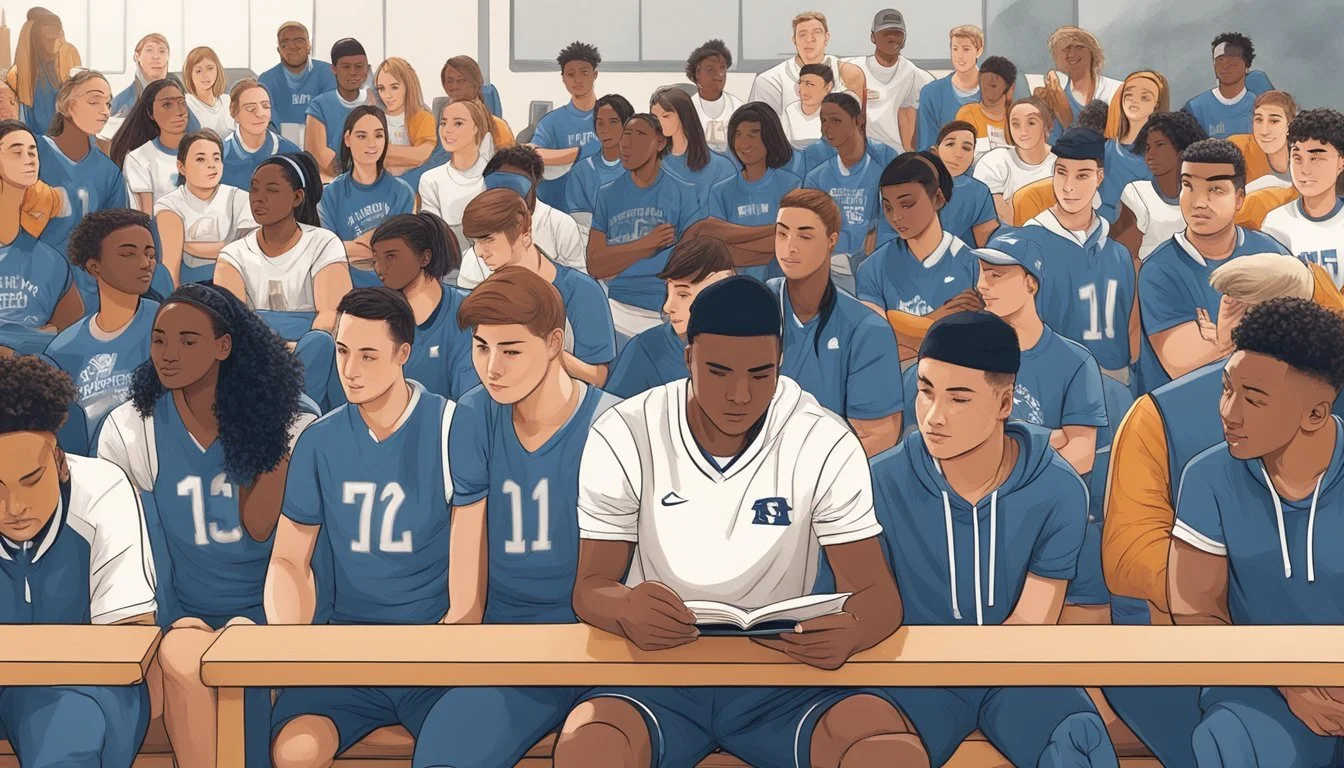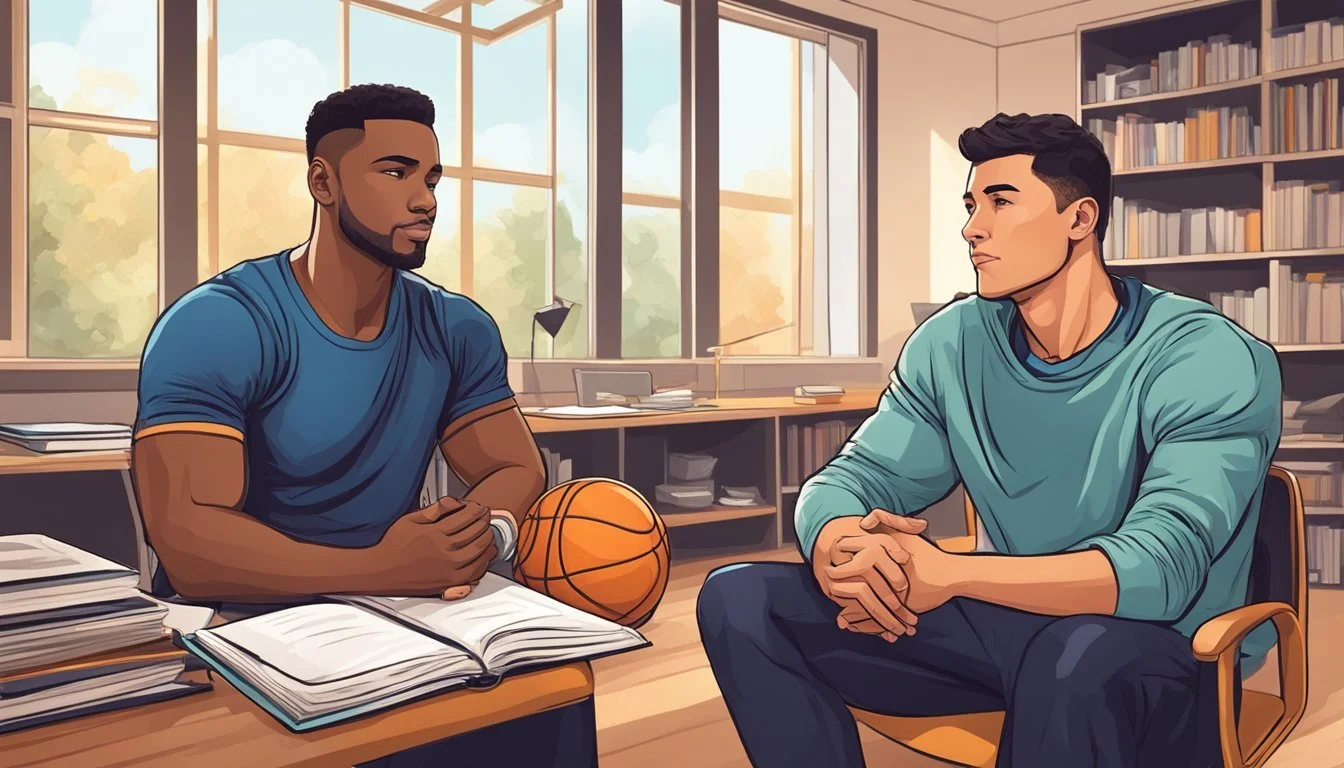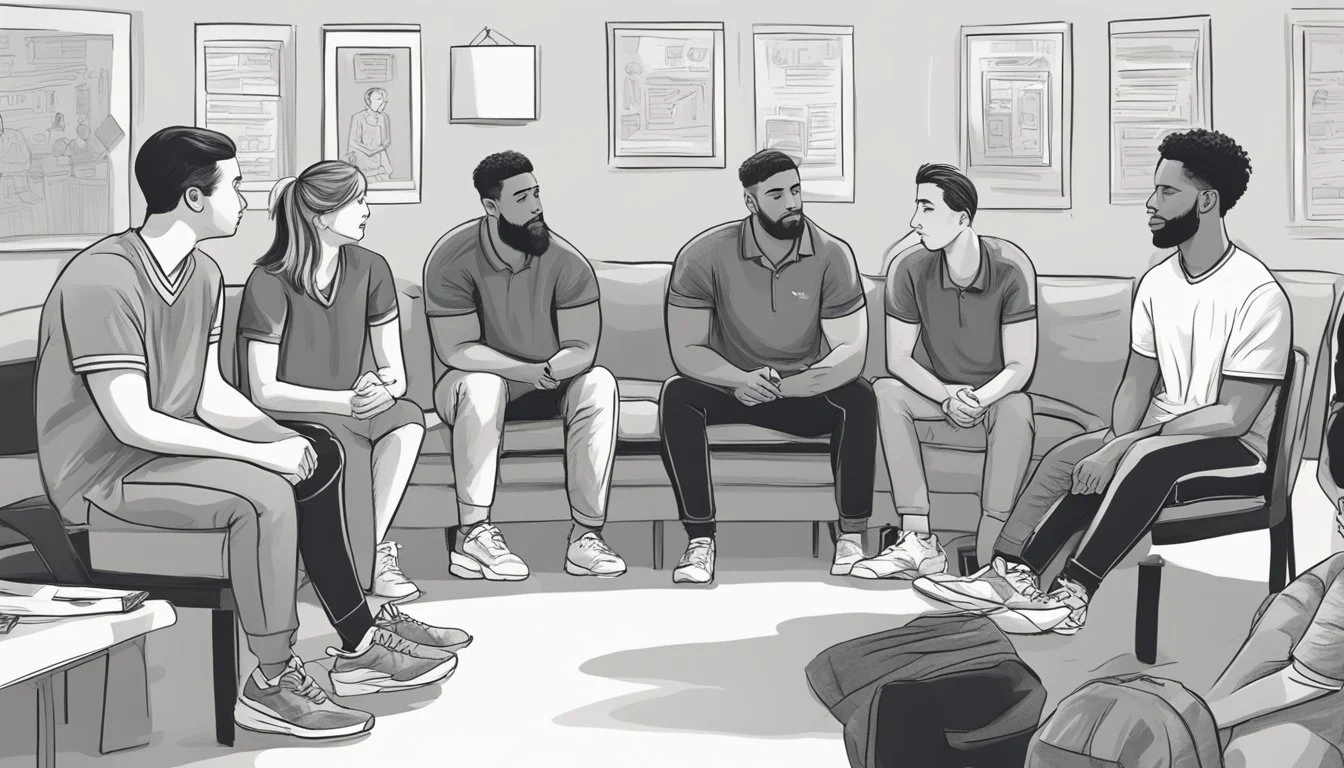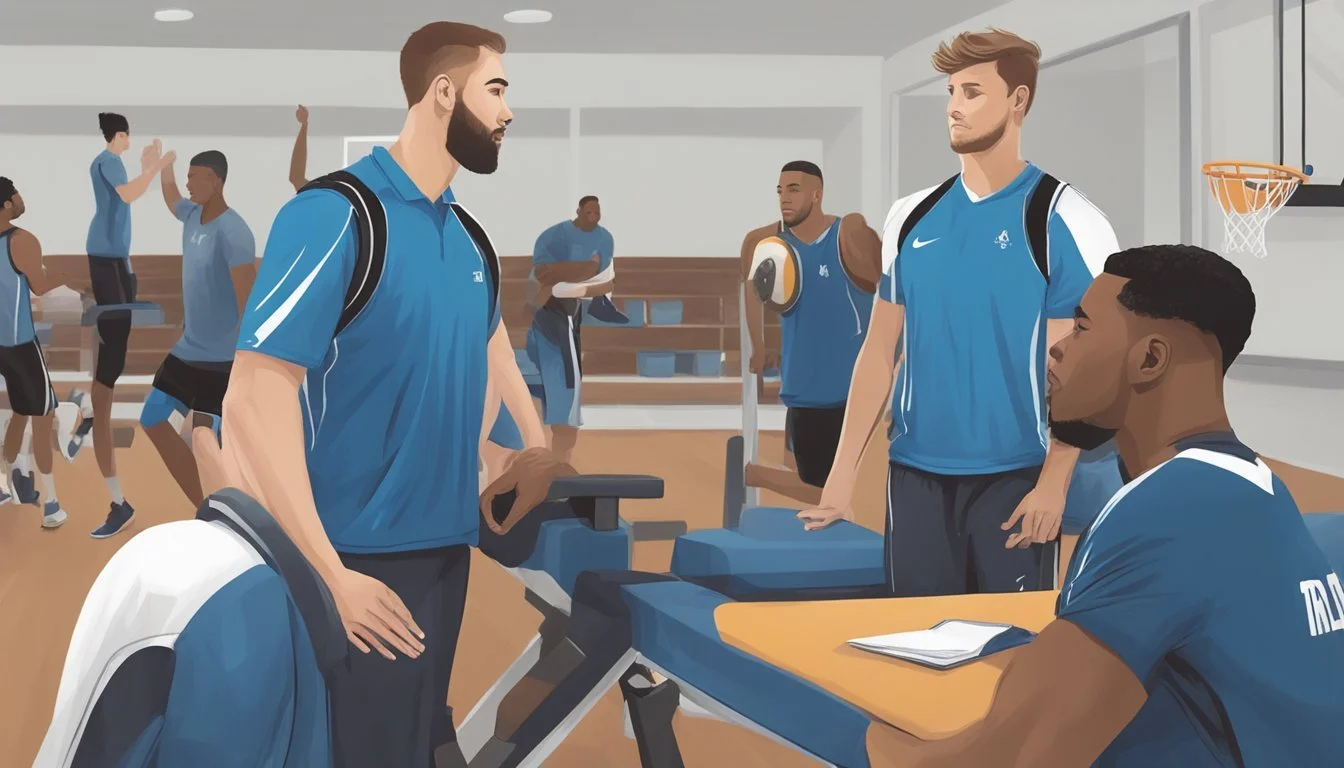8 Ways to Support a Student-Athlete with PTSD
Effective Strategies for Coaches and Parents
Supporting student-athletes with PTSD requires a nuanced approach that acknowledges both their athletic commitments and mental health needs. Understanding how to effectively offer this support can make a significant difference in their recovery and performance. Mental health professionals and athletic administrators must collaborate to create environments where student-athletes feel safe and supported.
The stresses faced by student-athletes can be uniquely intense, often exacerbating symptoms of PTSD. Providing tailored resources and fostering open communication can help mitigate these challenges. By focusing on the well-being of student-athletes, schools and sports organizations can help them thrive both on and off the field.
1) Encourage Professional Counseling
Encouraging professional counseling is crucial for student-athletes dealing with PTSD. Professional counselors, including sports psychiatrists, are trained to assess, diagnose, and treat mental health conditions specific to athletes. They understand the pressures and unique challenges that come with high-level sports competition.
A professional counselor can offer personalized treatment plans tailored to the athlete's needs. This might include cognitive-behavioral therapy, medication management, and other evidence-based interventions. These treatments aim to reduce PTSD symptoms and improve overall mental health.
It's important to normalize seeking help in athletic environments. Coaches and team staff should openly discuss the benefits of counseling and create a supportive atmosphere. Reducing stigma around mental health can empower athletes to seek the help they need.
Athletic departments can provide resources and information about mental health services. Awareness campaigns and workshops can educate both athletes and staff about the importance of mental health and professional counseling.
Offering access to mental health professionals as part of the team's support system can make a significant difference. By integrating these services into the athletic program, student-athletes can better manage PTSD.
Professional counseling is an essential component in ensuring the mental well-being of student-athletes. Encouraging its use demonstrates a commitment to the holistic health of the athletes.
2) Promote Healthy Sleep Habits
Encouraging student-athletes with PTSD to adopt healthy sleep habits is crucial for their recovery and performance. Sleep plays a vital role in emotional and physical well-being.
Athletic departments can benefit from using recommendations from sleep experts to improve sleep health. This can ultimately enhance both mental and athletic performance.
Project REST, for instance, is designed to help student-athletes develop better sleep routines, highlighting its importance. You can read more about this initiative here.
Aiming to get a consistent amount of sleep each night is essential. Teenagers usually need at least eight hours, while younger athletes need even more.
Tracking sleep and identifying patterns can help in finding and addressing issues promptly. This helps in creating a practical sleep schedule that suits their daily activities.
Finally, creating a sleep-friendly environment, such as minimizing light and noise, can significantly boost sleep quality. It is essential for them to have a place where they can rest without interruptions.
3) Provide a Support Network
A strong support network is essential for student-athletes dealing with PTSD. This network should include family, friends, coaches, and mental health professionals. Each member of this network plays a critical role in the athlete's recovery and ongoing mental health.
Family members and friends can offer emotional support and help create a safe environment. Coaches should be trained to recognize signs of PTSD and foster a team culture that prioritizes mental health. Building trust between athletes and coaches helps the student-athlete feel understood and supported.
Involving mental health professionals is crucial. They can provide specialized care, such as therapy and coping strategies tailored to athletes. Coaches and athletic departments can facilitate access to these professionals by maintaining relationships with sports psychiatrists.
Connecting the athlete with peer support groups can also be beneficial. Sharing experiences with others who understand the challenges of PTSD can reduce feelings of isolation. Educational workshops and team-building activities focused on mental health can strengthen this network further.
Providing a robust support network ensures the student-athlete doesn't face PTSD alone. This comprehensive approach helps address their mental health needs effectively. For more detailed strategies on student-athlete mental health, refer to the article on supporting mental health wellness.
4) Advocate for a Balanced Lifestyle
Encouraging a balanced lifestyle is crucial for student-athletes with PTSD. They need to manage their academic responsibilities, athletic commitments, and social interactions effectively. A well-organized schedule can help them allocate time for each aspect of their life.
Ensuring they get enough rest and proper nutrition plays a significant role in their overall well-being. Sleep and a balanced diet can enhance their focus and performance both in sports and academics.
It's essential to highlight the importance of downtime. Student-athletes should have time off from their rigorous routines to relax and engage in non-athletic activities. This helps in reducing stress and preventing burnout.
Promoting hobbies and interests outside of sports can also provide a mental break. Engaging in activities like reading, painting, or playing a musical instrument can be soothing and rejuvenating.
Social interactions are another crucial component. Encouraging them to spend time with friends and family can provide emotional support and a sense of normalcy, which is beneficial for their mental health.
By advocating for a balanced lifestyle, you can help student-athletes manage their PTSD symptoms and lead a more stable and fulfilling life. For more tips on balance, check out these student-athlete tips.
5) Encourage Mindfulness and Meditation
Mindfulness and meditation can significantly benefit student-athletes dealing with PTSD. By engaging in these practices, they can improve their focus and reduce distractions, which is crucial during training and competitions. Encouraging a few minutes of mindfulness exercises daily can help them maintain concentration and stay grounded.
Mindfulness techniques also offer a powerful way to manage stress. For student-athletes, stress can come from performance pressure, academic demands, or dealing with injuries. Consistent mindfulness practices can help them cope with these challenges more effectively.
Incorporating mindfulness into their routines can also aid in reducing PTSD symptoms. Research has shown that combining mindfulness, breathing, and physical movements, like those in yoga, can create a sense of calm and reduce physical and emotional stress. This can be particularly beneficial for those with PTSD.
Some trainers have found success by adding mindfulness meditation before physical exercises. This method can help athletes feel more comfortable and relaxed, which can improve their overall performance and reduce their fear of injury. Encouraging this practice can create a supportive environment for student-athletes.
Mindfulness is not just about mental calmness; it also enhances athlete well-being. By regularly practicing mindfulness, athletes may see improvements in mental health, reduced injury risk, and better recovery rates. This holistic approach can lead to a healthier and more resilient mindset.
6) Offer Academic Accommodations
Academic accommodations are vital for student-athletes with PTSD to ensure they have equal access to educational opportunities. These accommodations can range from extended time on exams to modified assignments.
Flexible deadlines can help student-athletes manage their time more effectively. Allowing extra time to complete assignments can reduce stress and improve performance.
Providing quiet spaces for tests and assignments is essential. These environments can help minimize distractions and anxiety, facilitating better concentration.
Incorporating alternative formats for learning materials, such as audiobooks or digital text, can cater to different learning preferences. This approach can make it easier for student-athletes to engage with the material.
Letting them record lectures can also be beneficial. This ensures they do not miss vital information during high-stress periods or if they need to step out for calming breaks.
Additionally, coordinating regular check-ins with academic advisors or counselors can provide continuous support. They can help monitor progress and adjust accommodations as needed.
For more detailed guidelines, the University of Washington outlines various academic accommodations for students with psychiatric disabilities. Implementing these accommodations can significantly help in creating a supportive learning environment.
7) Foster Open Communication
Open communication is key in supporting a student-athlete with PTSD. Encouraging honest discussions can create a safe environment for them to express their feelings and experiences.
Establishing a judgment-free zone is crucial. This lets the athlete feel comfortable sharing their thoughts without fear of criticism. It helps build trust between the student-athlete and their support system.
Coaches and parents can adopt an open-door policy, making it easier for athletes to seek help when needed. This approach can make a significant difference, especially during tough times.
Actively listening to the student-athlete is important. Pay attention to both verbal and non-verbal cues. This shows genuine interest and concern for their well-being.
Regular check-ins can be beneficial. These can provide an opportunity to discuss their mental and physical state. It ensures any issues are addressed promptly.
Encouraging group discussions within the team can help. Shared experiences can create a supportive community and reduce feelings of isolation.
Using positive language and reinforcing their efforts can further bolster their confidence. Such reinforcement acknowledges their struggles and achievements, promoting a healthier mental state.
For more insights on effective communication strategies, visit CICMH's resource on Mental Health Communication.
8) Educate About PTSD
Educating student-athletes about PTSD is crucial for their mental health. Posttraumatic stress disorder can affect anyone, regardless of age or social status. Understanding the symptoms and causes can help athletes recognize when they or their peers might need help.
Include information about PTSD in team meetings or training sessions. Share that PTSD can develop after experiencing or witnessing traumatic events, which can include severe injury, abuse, or the death of a loved one.
Discuss the emotional and physical symptoms of PTSD, such as nightmares, flashbacks, and emotional numbness. Make it clear that these reactions are normal responses to abnormal situations and remind athletes they are not alone.
Provide resources such as counseling services or mental health hotlines. Encourage athletes to seek help if they notice signs of PTSD in themselves or others. Connecting them with mental health professionals can offer the support they need.
Use real-life examples or testimonials from other athletes who have dealt with PTSD. Hearing stories from peers can reduce the stigma and make the topic more relatable. It may also encourage open discussions about mental health within the team.
Promote a supportive environment where athletes feel comfortable discussing mental health without fear of judgment. Creating a culture of openness and support can significantly aid in managing PTSD.
Recognizing PTSD Symptoms in Student-Athletes
Recognizing symptoms of PTSD in student-athletes is crucial for timely intervention. Key areas to observe include changes in behavior, emotional responses, and physical symptoms that can indicate the presence of PTSD.
Behavioral Changes
Behavioral changes are often the earliest and most noticeable signs of PTSD in student-athletes. They may include a sudden drop in performance or motivation. Athletes might start skipping practices or games, showing a lack of interest in a sport they once enjoyed. Other behaviors like increased irritability, frequent outbursts of anger, or unexplained mood swings are also red flags.
Isolation from teammates and friends can be another significant behavior to note. Athletes may withdraw socially, preferring to be alone rather than interacting with peers. This change can impact team dynamics and their overall wellbeing.
Also, look out for risky behaviors, such as substance abuse or reckless actions, which can be a coping mechanism for underlying trauma. These behaviors not only affect their athletic performance but also their personal lives.
Emotional Responses
Emotional responses can be deeply affected by PTSD, manifesting as intense feelings of fear, anxiety, or sadness. Student-athletes may experience heightened anxiety before events where they were previously confident. Even small triggers related to their trauma can cause intense emotional reactions.
It is common for individuals with PTSD to feel a persistent sense of dread or ongoing stress. They might seem overly on-edge or easily startled by loud noises or sudden movements. These emotional responses can interfere with their ability to focus during practices and competitions.
Another sign is emotional numbness or detachment. Athletes might exhibit a lack of enthusiasm or joy, appearing indifferent to wins or losses that once mattered greatly to them. This emotional blunting can extend beyond sports, affecting their interactions with family and friends.
Physical Symptoms
Physical symptoms often accompany the emotional and behavioral signs of PTSD. These may include chronic fatigue, insomnia, or other sleep disturbances. Lack of sleep can lead to poor performance, increased injury risk, and a general decline in health.
Student-athletes with PTSD might also complain of headaches, stomachaches, or other unexplained aches and pains. These physical complaints can sometimes be misunderstood as normal athletic fatigue, but they require closer attention when paired with emotional and behavioral changes.
Changes in appetite are also common. Some athletes may overeat to cope with stress, while others may lose their appetite altogether, both of which can lead to further health complications. Regular monitoring and prompt medical attention are essential to address these physical symptoms effectively.
Creating a Supportive Environment
Creating an environment that fosters trust and open communication is essential for supporting a student-athlete with PTSD. These elements help in addressing their unique challenges and promoting their overall well-being.
Establishing Trust
Building trust requires consistent effort and understanding. Coaches, caregivers, and peers should demonstrate reliability through consistent actions and words. This includes being punctual, honoring commitments, and providing a safe and non-judgmental space.
Confidentiality is crucial. Ensuring that any discussions about the student-athlete's mental health are kept private helps to reinforce trust. This means not sharing sensitive information without explicit permission.
It is also important to provide consistent emotional support. Active listening and showing empathy without offering unsolicited advice or judgment can make a significant difference. Recognizing and validating their feelings helps in building a stronger, more trusting relationship.
Fostering Open Communication
Open communication involves creating opportunities for honest and direct conversations. Regular check-ins that allow the student-athlete to express their feelings and concerns are important. These interactions should be supportive rather than intrusive.
Using clear and simple language avoids misunderstandings. Encouraging the student-athlete to ask questions and express their thoughts freely is essential. This can be facilitated through one-on-one meetings or informal talks.
Creating a feedback-friendly atmosphere is also beneficial. Allowing the student-athlete to give feedback about their experiences and the support they are receiving can lead to improved interventions and a more supportive environment overall.
Incorporating Professional Help
Professional intervention can be a crucial component in supporting a student-athlete with PTSD. This section explores the significance of working with mental health professionals and integrating different therapy options to address the unique needs of these athletes.
Working with Mental Health Professionals
Engaging with mental health professionals can provide targeted support to student-athletes suffering from PTSD. Licensed psychologists, psychiatrists, and sports psychologists are skilled in trauma-related issues. They can offer evidence-based treatments such as Cognitive Behavioral Therapy (CBT) and Eye Movement Desensitization and Reprocessing (EMDR), which are effective for PTSD.
Collaboration between coaches, parents, and mental health providers ensures a holistic approach. Coaches can benefit from training sessions on recognizing PTSD symptoms and knowing when to refer an athlete for professional help. Open communication channels between the athlete, their family, and the therapist are essential to monitor progress and adjust treatment plans as needed.
Regular consultations with a mental health professional can prevent the exacerbation of symptoms. It’s beneficial to include check-ins not just during crises but as part of ongoing care.
Integrating Therapy Options
Incorporating a variety of therapeutic approaches can be beneficial for addressing PTSD in student-athletes. Traditional talk therapy, including individual and group therapy, allows athletes to express their emotions and share experiences in a safe environment. These sessions can help reduce feelings of isolation and enhance coping mechanisms.
Alternative therapies like art, music, and movement therapy can also be valuable. These modalities provide non-verbal outlets for expression and healing, which can be particularly useful for those who struggle to articulate their trauma. Sports and physical activity therapies are essential, as they use movement to help integrate cognitive and physical recovery.
Additionally, incorporating mindfulness practices such as meditation and yoga can help athletes manage stress and anxiety. These techniques focus on breath control and awareness, promoting relaxation and mental resilience. Regular practice can create a calming routine that supports the overall therapeutic process.









